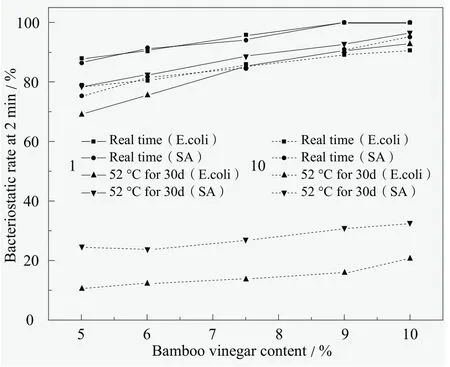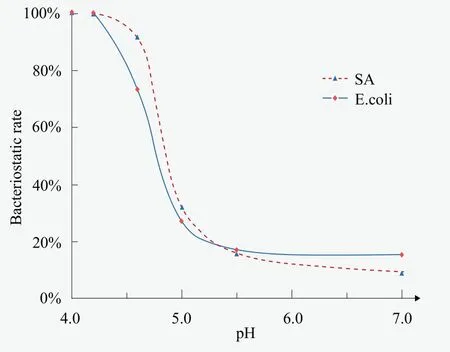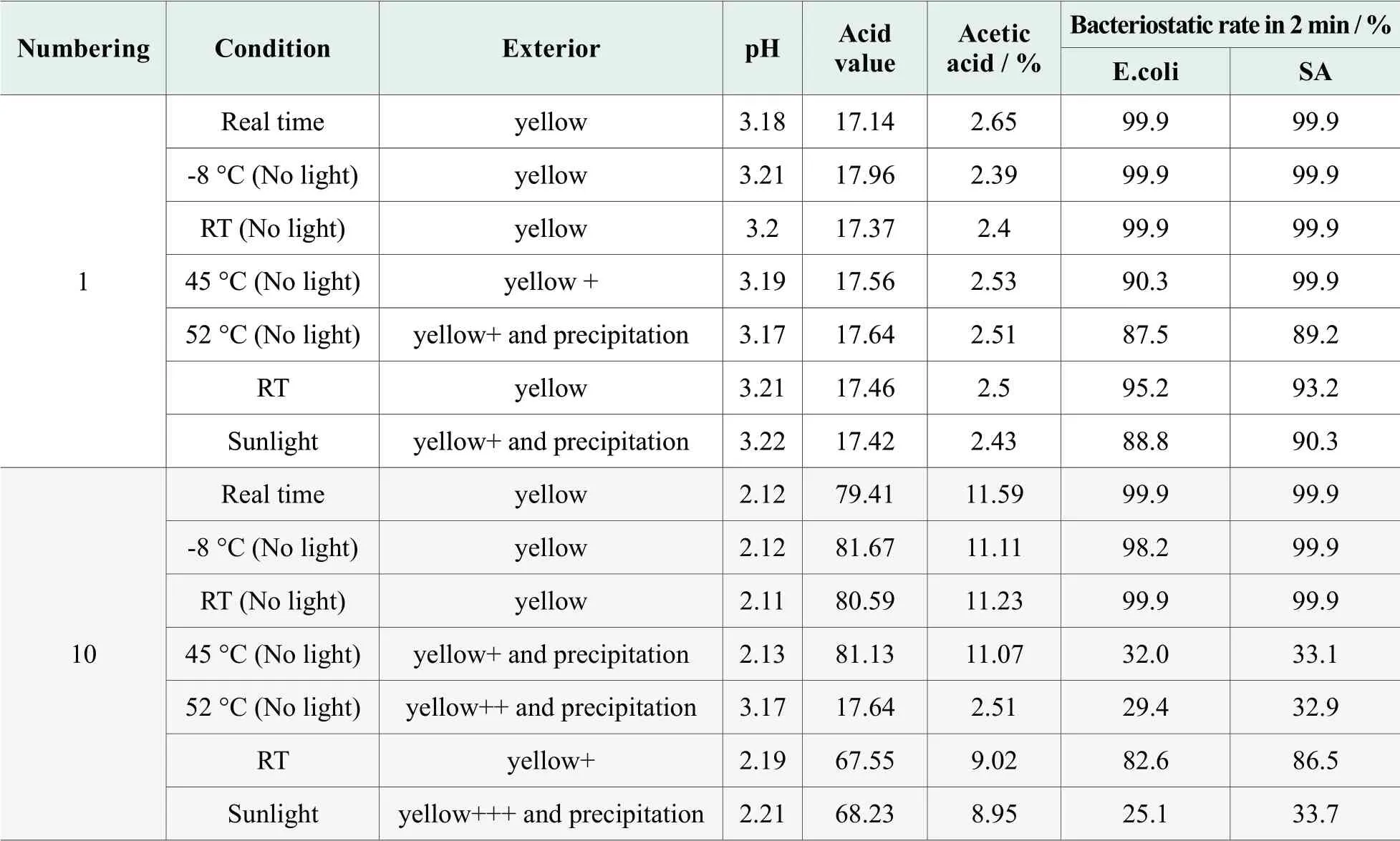Application Research of Bamboo Vinegar in Daily Chemicals
Duan Jianjun, Zhai Xiangsheng, Yang Huasheng, Wei Wei, Wang Qunyong, Yan Weinv
New Product Development Center of NICE Group Co., Ltd., China
Zhang Wenbiao
College of Engineering, Zhejiang Agriculture and Forestry University, China
Abstract
Key words
bamboo vinegar; daily chemicals; antibacterial; deodorization; application
Bamboo vinegar is an acidic liquid by-product obtained by charring pyrolysis of bamboo, with natural acetic acid and smoked aroma.The composition of bamboo vinegar is complex, contains hundreds of organic components and dozens of minerals.Its main component is water (80%), followed by organic acids, phenols, ketones, alcohols and so on.Zhang Wenbiao and Chen Shunwei used gas chromatography-mass spectrometry to identify and analyze the components of bamboo vinegar stock solution and refined bamboo vinegar ingredients.However, the test results of bamboo vinegar obtained by different bamboo species, different temperatures and different refined distillation methods are different.[1-4]
In recent years, many studies have found that bamboo vinegar has a good effect in sterilization and disinfection.[5,6]At present, the daily chemical products that claim to have antibacterial and sterilization functions have been recognized and accepted by most consumers, such as antibacterial hand sanitizer and laundry decontamination liquid.But such products are mainly added by chemically synthesized cationic compounds, or triclosan, triclocarban, PCMX and other fungicides to achieve its efficacy.[7,8]So bamboo vinegar derived from natural plants and renewable has broad application prospects.[9]This paper focuses on the antibacterial, odor, anti-fungal and other properties of bamboo vinegar, aiming to provide a theoretical basis for its application in daily chemical care products.
Experimental
Materials and instruments
The strains (Escherichia coli, Staphylococcus aureus and Aspergillus niger) were purchased from the Guangdong Provincial Collection of Microorganisms and Cultures.The hand soap base is self-made.Nutrient agar medium (NA), sand castle agar medium and sandcastle liquid medium were purchased from Guangdong Huankai Microbiology Technology Co., Ltd.Twelve batches of bamboo vinegar provided from Zhejiang Agriculture and Forestry University and eleven different companies respectively, randomly numbered from 1 to 12.
GR85DF autoclave, Xiamen Zhiwei Instrument Co., Ltd.; MJ-250I constant temperature incubator, DHG-9070A oven, Shanghai Yiheng Technology Co., Ltd.; BCD-316WYM Rongsheng refrigerator; HH-4 digital display constant temperature water bath, Changzhou Aohua Instrument Co., Ltd.; ultraclean workbench.
Experimental methods
Bacteriostatic experiment of bamboo vinegar and bamboo vinegar hand sanitizer
The bacteriostatic test was carried out on the bamboo vinegar samples with the original solution and the mass fraction of 10% and 5% respectively.The inhibition rate was determined by the suspension quantitative method with the action time of 2 min and 10 min.[10]The experiment was repeated three times and the average was taken.
The bamboo vinegar stock solution was added to the self-made hand soap base formula according to the gradient content and left at 52 °C for 30 days.The suspension quantitative method was used to carry out the 2 min bacteriostatic test on the instant sample and the retention sample to investigate the bacteriostatic stability of the bamboo vinegar solution in hand sanitizer.
Odor test of the bamboo vinegar liquid
The bamboo vinegar sample was prepared into a 10% solution with sterile distilled water, then dispensed into a spray bottle and distributed to 60 healthy volunteers (20 to 60 years old, half of men and women, no history of skin disease of the foot).The indwelling contrast test for the odor removal effect on the shoes worn on the daily basis: one as a blank sample and the other one for the experimental sample sprayed with bamboo vinegar.After 8 hours, smell-score was scored by sniffing according to the obvious effect (2 point), effective (1 point) and no effect (0 point), and the average value was used to evaluate the effect.
Effect of bamboo vinegar on Aspergillus niger
The minimum inhibitory concentration (MIC) and minimum bactericidal concentration (MBC) of bamboo vinegar samples against aspergillus niger were determined by constant broth dilution method.In addition, a gradient concentration of bamboo vinegar was prepared, and the aspergillus niger spores were inoculated separately, cultured in a 31 °C incubator for three days to observe the growth of the mold.The sterile distilled water was set as a blank control group.Records with mold growth were positive (indicated by +), and records without mold growth were negative (indicated by -).
Stability investigation on the bamboo vinegar
The bamboo vinegar is placed under different conditions (-8 °C, RT, 45 °C, 52 °C), different lighting (normal temperature and protected from light; normal temperature and light; direct sunlight) for one month.Track and test the appearance, pH, acid value, acetic acid content and inhibition rate of 10% mass fraction to investigate stability of the bamboo vinegar.
Results and discussion
Antibacterial properties of bamboo vinegar
The bacteriostatic test results of each sample are shown in Table 1.It can be seen from Table 1 that when the time of action on escherichia coli and staphylococcus aureus is 2 min and 10 min, most of the bamboo vinegar stock solution has a better inhibitory effect.When the mass fraction is lowered, the bacteriostatic effect of each sample is also reduced.At low mass fractions and short durations, only two samples (numbered 1 and 10) performed better.

Table 1.Antibacterial results of various bamboo vinegar samples under different conditions

Figure 1.Antibacterial rate test of different amounts of bamboo vinegar in hand sanitizer

Figure 2. Change in antibacterial rate of hand sanitizer at different pH

Table 2.Analysis results of evaluation data for removing odor by bamboo vinegar
Application test of bamboo vinegar in hand sanitizer
The bamboo vinegar with the number of 1, 10 were taken as the research object, and the application in the formula of ordinary hand sanitizer was investigated.The results are shown in Figure 1.It can be seen from Figure 1 that after adding bamboo vinegar to ordinary hand sanitizer (the antibacterial rates to E.coli and SA are less than 15%), the instant inhibition rate is more than 70%.When the formula addition amount is 10%, the antibacterial rate of the hand sanitizer reached more than 90%.The results of stability investigation showed that the antibacterial effect of all bamboo vinegar hand sanitizer sample decreased under different conditions at 52 °C.Compared with sample 10, the antibacterial effect of sample 1 was ideal.
Further study on the effect of pH on the antibacterial effect of hand sanitizer added with 10% bamboo vinegar, the experimental results are shown in Figure 2.It can be seen from Figure 2 that the pH value has a great influence on the inhibition rate of the bamboo vinegar solution.When the pH value is lower than 4.5, the bacteriostatic effect is excellent; when the pH is greater than 5, the bacteriostatic effect is deteriorated obviously.It shows that if the hand sanitizer is to be applied with bamboo vinegar to achieve antibacterial function, the pH control of the formulation system is very important.Therefore, comprehensive consideration is given to formula design and raw material selection, so that bamboo vinegar can exert maximum antibacterial efficiency in the formula.
Deodorization performance of bamboo vinegar
The deodorization retention test results of 1 and 10 are shown in Table 2.It can be seen from Table 2 that the bamboo vinegar has an excellent deodorizing effect on the shoes worn everyday.The sample 10 has an effect, while the sample 1 has a significant effect.
Effect of bamboo vinegar on the growth of aspergillus niger
The effects of bamboo vinegar on the growth of aspergillus niger are shown in Table 3 and 4.From the Table 3, the MIC and the MBC of 1 was 4% and 11% respectively, and 10 had an MIC of 11% and an MBC of more than 25%.As can be seen from Table 4, the amount of bamboo vinegar added with 1 was 0.002% to 0.2% compared with the blank sample, and it was positive (+) after three days of culture, while the amount of bamboo vinegar added with 10 was 0.02% to 10%, also positive after three days of culture.That is to say, when the concentration of bamboo vinegar is relatively low, the antibacterial ability is greatly weakened, and the organic components contained therein become nutrients required for spore growth, which promotes the growth of aspergillus niger.
Stability of bamboo vinegar
The bamboo vinegars 1 and 10 were investigated for stability for 1 month under different storage conditions.The experimental results are shown in Table 5.It can be seen that temperature and light have certain influence on the stability of bamboo vinegar.The appearance color will be deepened, and even solid matter precipitates on the container.The pH, acid value and acetic acid content of the bamboo vinegar 1 were basically stable, and the antibacterial performance decreased slightly.While the above indicators of bamboo vinegar 10 showed large fluctuations, and the bacteriostatic performance was also significantly weakened.
Conclusion
Through the antibacterial performance test, two batches of bamboo vinegar raw materials with good performance were screened out, which have good antibacterial effect on common Staphylococcus aureus and Escherichia coli.Applying hand sanitizer products under specific formulation conditions can achieve excellent antibacterial efficacy.Bamboo vinegar has obvious deodorizing effect, and it also has certain inhibition and killing effect on mold.It is worth noting that bamboo vinegars of different sources have great difference, so screening and quality control are needed.Light and temperature can affect its quality stability.Therefore, packaging and storage conditions have certain requirements.When applying, it is necessary to avoid various unfavorable factors.

Table 3.Growth of Aspergillus niger in different concentrations of bamboo vinegar

Table 4.Growth of Aspergillus niger in low bamboo vinegar concentration for 3 days

Table 5.Stability of bamboo vinegar
 China Detergent & Cosmetics2019年3期
China Detergent & Cosmetics2019年3期
- China Detergent & Cosmetics的其它文章
- Experimental Design of Cosmetics Human Efficacy Evaluation
- Determination of Paeonol in Detergent by High Performance Liquid Chromatography
- Fluorinated Surfactants and Fluorinated Polymer Materials (III): Personal Opinion on the Problems of PFOS
- A New Method to Improve the Product Stability and Performance of Soap-based Cleanser at Two Different Temperatures
- Safety and Risk Management of Cosmetic Products
- Innovation Reshapes the Future of Detergent Industry in China
